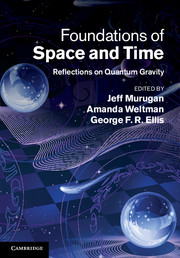Book contents
- Frontmatter
- Contents
- List of contributors
- 1 The problem with quantum gravity
- 2 A dialogue on the nature of gravity
- 3 Effective theories and modifications of gravity
- 4 The small-scale structure of spacetime
- 5 Ultraviolet divergences in supersymmetric theories
- 6 Cosmological quantum billiards
- 7 Progress in RNS string theory and pure spinors
- 8 Recent trends in superstring phenomenology
- 9 Emergent spacetime
- 10 Loop quantum gravity
- 11 Loop quantum gravity and cosmology
- 12 The microscopic dynamics of quantum space as a group field theory
- 13 Causal dynamical triangulations and the quest for quantum gravity
- 14 Proper time is stochastic time in 2D quantum gravity
- 15 Logic is to the quantum as geometry is to gravity
- 16 Causal sets: discreteness without symmetry breaking
- 17 The Big Bang, quantum gravity and black-hole information loss
- 18 Conversations in string theory
- Index
- References
14 - Proper time is stochastic time in 2D quantum gravity
Published online by Cambridge University Press: 05 August 2012
- Frontmatter
- Contents
- List of contributors
- 1 The problem with quantum gravity
- 2 A dialogue on the nature of gravity
- 3 Effective theories and modifications of gravity
- 4 The small-scale structure of spacetime
- 5 Ultraviolet divergences in supersymmetric theories
- 6 Cosmological quantum billiards
- 7 Progress in RNS string theory and pure spinors
- 8 Recent trends in superstring phenomenology
- 9 Emergent spacetime
- 10 Loop quantum gravity
- 11 Loop quantum gravity and cosmology
- 12 The microscopic dynamics of quantum space as a group field theory
- 13 Causal dynamical triangulations and the quest for quantum gravity
- 14 Proper time is stochastic time in 2D quantum gravity
- 15 Logic is to the quantum as geometry is to gravity
- 16 Causal sets: discreteness without symmetry breaking
- 17 The Big Bang, quantum gravity and black-hole information loss
- 18 Conversations in string theory
- Index
- References
Summary
We show that proper time, when defined in the quantum theory of 2D gravity, becomes identical to the stochastic time associated with the stochastic quantization of space. This observation was first made by Kawai and collaborators in the context of 2D Euclidean quantum gravity, but the relation is even simpler and more transparent in the context of 2D gravity formulated in the framework of CDT (causal dynamical triangulations).
Introduction
Since time plays such a prominent role in ordinary flat space quantum field theory defined by a Hamiltonian, it is of interest to study the role of time even in toy models of quantum gravity where the role of time is much more enigmatic. The model we will describe in this chapter is the so-called causal dynamical triangulation (CDT) model of quantum gravity. It starts by providing an ultraviolet regularization in the form of a lattice theory, the lattice link length being the (diffeomorphism-invariant) UV cut-off. In addition, the lattice respects causality. It is formulated in the spirit of asymptotic safety, where it is assumed that quantum gravity is described entirely by “conventional” quantum field theory, in this case by approaching a non-trivial fixed point [1, 2]. It is formulated in space-times with Lorentzian signature, but the regularized space-times which are used in the path integral defining the theory allow a rotation to Euclidean space-time. The action used is the Regge action for the piecewise linear geometry.
- Type
- Chapter
- Information
- Foundations of Space and TimeReflections on Quantum Gravity, pp. 338 - 362Publisher: Cambridge University PressPrint publication year: 2012

